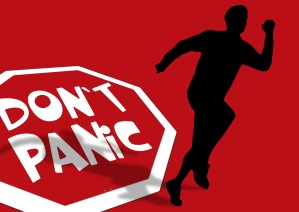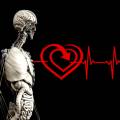Although it might feel like you’re dying, you’re not. That’s just what the panic wants you to think.
Disclaimer: Because panic attacks can mimic the symptoms of several serious medical conditions, it’s important that you talk with your doctor before beginning any panic treatment program. Never begin panic treatment without first obtaining medical clearance from your physician.
Panic attacks feel horrible.
If you are one of the 5% of Americans suffering from recurrent panic attacks due to panic disorder, you are likely well-acquainted with the nasty constellation of physical sensations that occur during a full-blown panic attack. Panic attack symptoms are frightening and often include accelerated heart rate, sweating, trembling, choking or smothering sensations, chest pain, nausea or GI problems, dizziness, lightheadedness, feelings of unreality or detachment from one’s body, numbness or tingling sensations, chills, and hot flashes (Barlowe & Craske, 2006). These symptoms reflect activation of the body’s fight-or-flight system, which has been implicated in panic. Physical symptoms frequently co-occur with intense worries and fears, such as fear of dying, losing control, or going crazy.
One of the primary reasons that panic is so scary is because it often masquerades as something other than itself. Just ask the closest ER doc, who might tell you that up to 20% of ER visits are panic-related (Julien, 2001). In many cases, individuals who have panic attacks don’t understand what’s happening to their bodies and misinterpret panic attack symptoms as symptoms of a heart attack or another serious medical condition. As a psychologist in Palm Beach, Florida, I work closely with physicians throughout the greater Palm Beach, Fort Lauderdale, and Miami areas to help individuals recover from panic attacks, panic disorder, and generalized anxiety.
Individuals with panic often live in fear about when the next attack might occur. Because these attacks can be unpredictable and may occur “out of the blue,” they often leave the panic sufferer feeling frightened and out-of-control. As a consequence, many individuals with panic try to anticipate and avoid any situations in which panic might arise.
Although this reaction to panic is understandable, unfortunately, it perpetuates the panic cycle.
Panic is maintained and strengthened through safety behaviors and avoidance. As such, breaking free from panic involves two primary steps: 1) learning to think differently about your symptoms, and 2) adopting behaviors that are incompatible with panic. These are the two bedrocks of cognitive behavioral therapy (CBT) for panic.
Just as is the case for other anxiety disorders, the secret to overcoming panic is based on behavioral exposure exercises. To overcome your panic, your approach must be multifaceted:
1. Counter your body’s natural impulse to escape. We are genetically, evolutionarily, and socially wired for self-preservation (see Darwin’s [1859] On the Origin of Species). Panic capitalizes on this instinct and uses it to its own advantage. Because panic is maintained by avoidance, every time you prematurely leave a situation in which you are panicking, you sensitize yourself to panic. This actually increases the likelihood that you’ll have a panic attack the next time you are in a similar situation.
The next time you experience a panic attack, stay in the situation until your panic symptoms have passed. If you do this consistently, you will weaken the panic cycle. When implemented in combination with the tips below, you will become much less prone to having panic attacks in the future.
2. Overcome your fear of uncomfortable physical sensations. Much of the research literature on panic has supported the importance of completing behavioral exposures to “interoceptive cues”, which are the scary physical symptoms that accompany panic. Interoceptive exposures involve purposefully exposing yourself to these cues (Barlowe & Craske, 2006). For example:
- Individuals who are particularly sensitized to accelerated heartbeat should practice engaging in activities that make their hearts beat faster.
- Individuals who are afraid of dizziness and nausea should practice activities that induce lightheaded sensations.
For most individuals, this idea initially seems counter-intuitive. Why purposefully practice something that is uncomfortable? The reason is that if you can eliminate your fear of experiencing uncomfortable sensations, you’ll be less anxious when you experience the same symptoms in daily life. This reduction in anxiety decreases the occurrence of panic attacks. With regular practice, you will eventually habituate to these symptoms and be able to tolerate them without fear. Ultimately, you will become immunized against these symptoms and will experience fewer and fewer panic attacks.
3. Learn to avoid avoidance. Panic robs individuals of treasured experiences. Activities that previously were enjoyable become tainted by the possibility of panic and anxiety, and these activities come to be endured or avoided, rather than enjoyed. This is particularly true for any activities that cause physical symptoms that mimic panic-like sensations. The clinical term for this panic-related avoidance is agoraphobia. Consequently, it is not uncommon for individuals with panic to avoid activities like physical exercise, drinking caffeine, or even engaging in sexual activity (Barlowe & Craske, 2006). To break free from panic, refuse to let panic factor into your decision making when planning activities. You might even purposefully engage in activities that you know will be physically activating.
4. Recognize “maladaptive safety behaviors” and challenge them. Many individuals with panic develop safety behaviors that undermine their independence and maintain the fear cycle. Safety behaviors common to individuals with panic include:
- Leaving the house only when armed with a ready supply of “rescue meds.”
- Preemptively making an “escape plan” when attending social events or other activities previously associated with panic.
- Participating in anxiety-related activities only when accompanied by a “safety person” (e.g., when going to the grocery store).
To reduce the occurrence of panic attacks, work on gradually decreasing your safety behaviors until you are able to complete these activities independently. This will also make you less prone to later relapse.
Next time you panic, remind yourself that although it might feel like you’re dying, you’re not. That’s just what the panic wants you to think. Incidentally, you should know that you’re in good company. Remember that Darwin guy I cited earlier? He was a famous panicker too, and I think we’d all agree that he made quite a name for himself.
Questions? Comments? Sound off below.
Want Updates about New Content?
Follow Me!
Follow @drstevenseay













Hello, So, for maybe the past 2 years, I’ve had crazy anxiety and depression and ocd. But with those 2 years, I’ve also felt like I was going to die soon. I would have dreams of me dying and I would wake up and take it as a sign. I am so scared because I love life. I’m only 17 but with these feelings I’m scared and almost convinced that I won’t make it to 18 or 19 or 20 and so on. I’ve been on Prozac but haven’t been taking it for a few weeks. I’m really scared. Please help me.